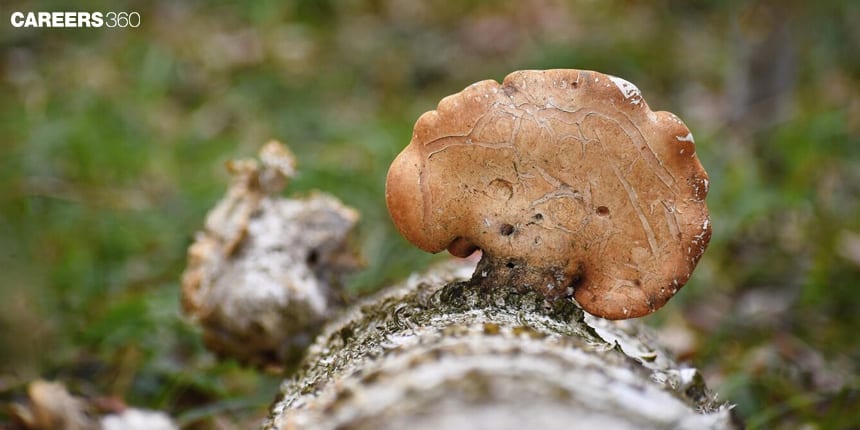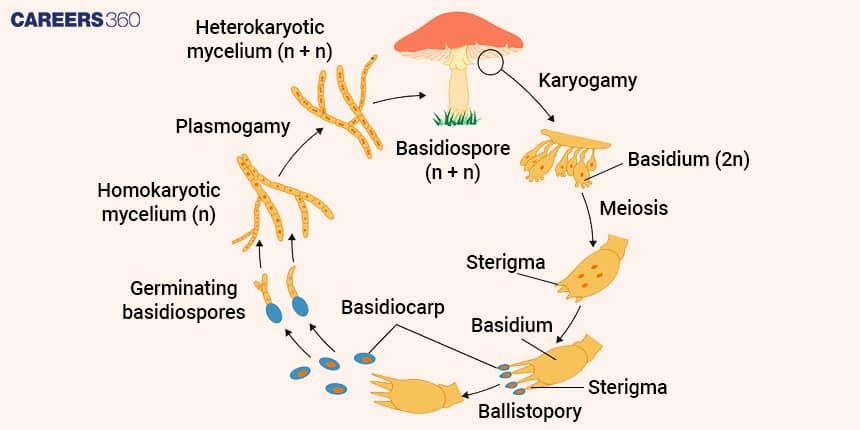Basidiomycetes - Definition, Meaning, Classification, Importance, Topics
What Are Basidiomycetes?
Basidiomycetes are a class of fungi that belong to the phylum Basidiomycota. They are characterised by Basidiospores produced on special cells called basidia. They deal with mushrooms, puffballs, shelf fungi, rusts and smuts.
This study group represents a remnant of some of the earliest mycological work into Fungi, most of it dating back to the essentially 18th and early 19th Centuries, even though the first person really to attempt any formal classification of fungal forms was one Christian Hendrik Persoon, or Persoon for short. Elias Magnus Fries provided major early work, but the full details of life cycles and reproductive mechanisms only became clarified following the advent of microscopic methods in the 20th Century.
NEET 2025: Mock Test Series | Syllabus | High Scoring Topics | PYQs
NEET Important PYQ's Subject wise: Physics | Chemistry | Biology
New: Meet Careers360 B.Tech/NEET Experts in your City | Book your Seat now
- What Are Basidiomycetes?
- Classification and Taxonomy
- General Characteristics
- Habitat And Ecology
- Reproduction In Basidiomycetes
- Examples Of Basidiomycetes
- Economic And Ecological Importance
- Research And Applications

Classification and Taxonomy
Kingdom: Fungi
Basidiomycetes belong to the huge kingdom of Fungi. This huge group mainly consists of fungi that acquire their nutrition by decomposing, in which the microorganisms derive their food from organic matter by absorption.
Phylum: Basidiomycota
Basidiomycetes are classified under the phylum Basidiomycota. The broad characteristic of this type of fungi is the formation of club-shaped basidia on which sexual spores are formed.
Classes within Basidiomycetes
There are several classes of Basidiomycetes, each consisting of a large group of fungi with distinct features:
Agaricomycetes: This class includes most mushrooms, shelf fungi and puffballs. Characterised by possession of fruiting bodies.
Ustilaginomycetes: These are the smut fungi, which represent plant pathogens.
Pucciniomycetes: Another class of fungi that act as plant pathogens for crops are the rust fungi.
Tremellomycetes: These include jelly fungi and are found mostly on dead, decaying wood.
General Characteristics
The general characteristics of Basidiomycetes point out their complexity concerning morphology, reproductive structures, and life cycle:
Morphological Features
Basidiomycetes show such a wide range of morphological forms as the familiar mushroom shapes, but also somewhat unusual shapes, like puffballs, shelf fungi, and jelly fungi. Despite the quite striking differences in their morphology, all of them share common structural features that are integral to their identification and classification.
Basidiocarp Structure
The basidiocarp, the fruiting body, which produces spores is part of the Basidiomycetes that varies at large in size shape and colour. It usually consists of the pileus, an umbrella structure above that protects the spore-producing surfaces. lamellae are thin structures under the cap where basidia and basidiospores are developed although some have pores such as spines. The stipe is the stalk that supports the cap and in a way helps to disperse spores. The annulus is the ring that comprises the remains of the partial veil that initially covers immature gills, and the volva is a cup comprising the remains of the universal veil enveloping the whole mushroom when immature.
Basidia And Basidiospores
Basidia are tiny, roughly club-shaped cells that form on the gills, pores, or other spore-bearing surfaces of the basidiocarp. Karyogamy followed by meiosis takes place in a basidium, generating four haploid basidiospores. Basidiospores are spores formed by Basidiomycetes, usually in four-spored bundles on each basidium dispersed to the environment and germinated to produce new fungal mycelium.
Life Cycle Overview
Basidiomycetes life cycle depicts two modes, such as sexual reproduction and asexual reproduction and it is characterised by the following phases:
Spore Germination: The basidiospore germinates to produce haploid primary mycelium.
Plasmogamy: The fusion of two compatible hyphae from two different mating types forms dikaryotic secondary mycelium. Besides, its cell contains two nuclei.
Dikaryotic Mycelium: It is a more prolonged stage that forms a massive network, later it develops a fruiting body, known as basidiocarp.
Karyogamy: Nuclei fuse to become a diploid zygote inside basidia.
Meiosis: The same diploid zygote undergoes meiosis and gives haploid basidiospores.
Basidiomycetes life cycle diagram
The diagram given below shows the overview of the basidiomycetes life cycle.

Habitat And Ecology
Basidiomycetes are found in a wide variety of natural ecological habitats, like forests and grasslands, decaying wood and soil. Ecologically, they provided important services, such as the decomposition of organic matter and nutrient cycling. Moreover, in symbiotic relationships, particularly mycorrhizal, facilitate better uptakes of nutrients and water by partner organisms-plants. Other Basidiomycetes are parasitic to a greater extent, and some taxa infect a wide array of host organisms, including plants.
Reproduction In Basidiomycetes
Basidiomycetes have both sexual and asexual reproduction methods. Under sexual reproduction, after the dikaryotic stage fusing of two compatible hyphae where each cell now contains two the basidiospores develop on basidia. The stage in the life cycle characteristically features the formation of clamp connections to ensure the proper distribution of the nuclei. Asexual spores are reproducible by several types; among the common kinds are conidia and chlamydospores. They aid in the rapid colonisation and survival in different environments.
Examples Of Basidiomycetes
These examples clearly illustrate the diverse functions and importance of Basidiomycetes, ranging from kitchen to environment and also in industry.
Edible Mushrooms
Agaricus bisporus: This is commonly known as the button mushroom. It is widely cultivated and consumption dates back centuries in most parts of the world. It offers a gentle flavour and is a very versatile fungus in the kitchen.
Pleurotus ostreatus: Factors contributing to the popularity of the oyster mushroom relate to its delicate texture and mild flavour. Besides, it is reputed to be a very healthy mushroom, high in protein as well as fibre content.
Poisonous Mushrooms
Amanita phalloides: Otherwise known as the death cap, this extremely toxic species of mushrooms contains very powerful toxins that cause grave damage to the liver and kidneys. If eaten, it is generally fatal.
Pathogenic Fungi
Puccinia graminis: More commonly known as the black stem rust, it is a very serious pathogen of cereal crops belonging to wheat. It leads to decisive crop loss and is a serious headache for the agriculturalist as such.
Industrially Important Fungi
Ganoderma lucidum: Commonly known as reishi or lingzhi, this fungus is widely famous for its medicinal value. Since time immemorial, this fungus has been used in traditional medicine and modern dietary supplements that are normally administered to stimulate immune effects and cancer.
Economic And Ecological Importance
Basidiomycetes are very important economically as well as ecologically. Edible fungi such as Agaricus bisporus, and Pleurotus ostreatus, provide excellent nutrition value since they contain a high amount of protein, fibre and vitamins. Medicinally, fungi for example Ganoderma lucidum are applied for their antibiotic properties and immunomodulatory effects. In agriculture, Basidiomycete can be beneficial to crops through mycorrhizal associations thus enhancing the plant's growth or adverse as pathogens about diseases such as wheat rust- Puccinia graminis. They also play a very important role environmentally in decomposition and nutrient cycling with the breakdown of organic matter and return of nutrients to the ecosystem.
Research And Applications
The research work on Basidiomycetes has given way to several biotechnological applications such as enzyme production for industrial processing and bioremediation for cleaning environmental pollutants. Genetic and metabolic diversity is presently under exploitation for new pharmaceuticals, sustainable agriculture, and renewable energy sources. Future promises include their exploitations in synthetic biology, enhancement of carbon sequestration, and new methods for environmentally conservative and resource management.
Conclusion
They belong to a very diverse class of fungi and play important roles in ecosystems - as decomposers, symbionts, or pathogens. Their reproductive structures and life cycles are unique, their relationships in agriculture are beneficent or deleterious and they have an economic impact as food and medicine. Studying Basidiomycetes to appreciate biodiversity, improve agriculture and advance biotechnology and environmental sciences has become extremely important to understand their multifaceted importance in natural and human-modified environments.
The video on Basidiomycetes is given below:
Frequently Asked Questions (FAQs)
The basidiomycetes class of fungi that are spore-producing organisms facilitated by the use of basidia. Almost all sorts of habitat-from forests to grasslands, decaying pieces of wood to soil-have evidence of the existence of these organisms.
Basidiomycetes produce spores on basidia, whereas Ascomycetes produce spores in sac-like structures called asci. Also, Basidiomycetes mostly have complex fruiting bodies like mushrooms.
Major groups include edible mushrooms like Agaricus bisporus, or the button mushroom and Pleurotus ostreatus or the oyster mushroom; poisonous mushrooms like Amanita phalloides or the death cap; medicinal mushrooms like Ganoderma lucidum or the reishi.
This cycle of life of the fungus includes the following: spore germination, mycelium formation, plasmogamy fusion of hyphae, dikaryotic stage, karyogamy nuclear fusion, meiosis and produce new basidiospores.
Basidiomycetes are decomposers of fungi that break organic matter, forming symbiotic mycorrhizal associations with plants. In some species, basidiomycetes pathogens affect crops and other plants.
Also Read
30 Nov'24 12:23 PM
28 Nov'24 05:34 PM
25 Nov'24 05:18 PM
23 Nov'24 10:02 AM
22 Nov'24 01:59 PM
21 Nov'24 04:58 PM
16 Nov'24 01:58 PM